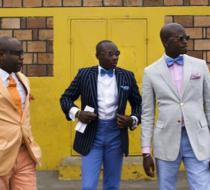In Brazzaville, Fashionistas Lift Spirits With Apparel And Activism 1 Favorite
When can fashion be considered an act of social activism — even subversion?
The streets of Brazzaville, Republic of the Congo’s capital (Congo-Brazzaville), have seen plenty of violence and suffering over the years. But a group of local fashionistas known has “sapeurs” are lifting spirits and celebrating life by following a simple commandment: Dress to impress.
At first glance, La Sape — short for the “Society for the Advancement of Elegant People” — is a slightly surreal concept. After all, it’s not every day one sees men roaming the streets of a depressed, war-torn country dressed in candy-colored three-piece suits, bow ties and fedoras.
Most “sapeurs” have ordinary jobs as electricians, taxi drivers or policemen, but they find that dressing with style helps them transcend their often dire circumstances.
“Even if I don’t have money in my pocket, I only need to wear a suit and tie to feel really at ease,” says Prince Armel, a young sapeur who works as a painter.
La Sape first emerged as as a way to resist French colonialism. In the 19th century, servants often got paid by their wealthy employers in clothing instead of money, so they began to embrace a European dress style as a means of combating colonial superiority.
Today there are some popular luxury shops and tailors in Brazzaville, but most sapeurs prefer to get their clothes directly from the old world, requisitioning or buying them from friends who visit from fashion hubs like London and Paris. Every sapeur dreams of visiting the City of Lights to get their hands on their favorite labels, which tend to be Dior, Gucci, Jean Paul Gaultier, Armani, Kenzo, Versace and Yamamoto.
Buying such style isn’t cheap; a single pair of trousers can sell for as much as $300, and imitations are not tolerated. The average national income per capita in Congo-Brazzaville is an estimated $3400, which puts buying $1,300 pairs of crocodile shoes or $3000 designers suits in perspective. Sapeurs often borrow money or even clothes from one another to complete the look, and some have been known to rent designer suits for $25 a day.
Spending money on canes and silk socks might seem frivolous in a country where just under half the population lives in poverty, but the movement aims to do more than help people forget their troubles. It has become a subtle form of social activism. The first sapeurs started by emulating French “dandies” but quickly got creative and added their own spin on the style as an act of subversion.
“The white man may have invented clothes, but we turned it into an art,” says famous Congolese musician King Kester Emeneya, who helped popularize the style.
Sapeurism is more than just a sartorial style; it’s also a philosophy. Sapeurs may revere the top designers, but they believe it’s not so much the value of the clothes as the man who wears them. So they must abide by a code of honor that dictates they behave like true gentlemen, reflecting grace and respect with each swaggering step.
“I don’t see how anyone in La Sape could be violent or fight. Peace means a lot to us,” says Severin, a 78-year-old whose father was also a sapeur.
After years of civil conflict, some have found that La Sape can even help heal the wounds of infighting.
“The war created a lot of ethnic division, especially between the north and the south. But La Sape is what allows us to come together again,” says Ferole Ngouabi. These days, he and his fellow sapeurs only fight over who’s wearing the most dazzling outfit when they gather to dance Congolese rumba.
Their movement brings color and hope to the lives of Congo’s downtrodden, and they’ve recently been gaining in notoriety — so much so that sapeurs are the stars of a Guinness commercial, celebrating their individual styles and strutting their stuff.






